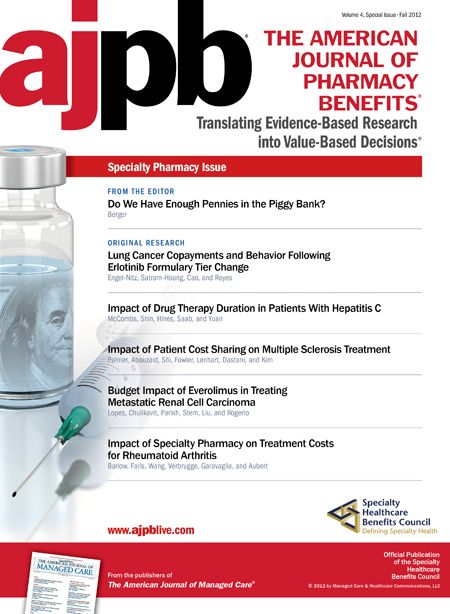Publication
Article
AJPB® Translating Evidence-Based Research Into Value-Based Decisions®
Do We Have Enough Pennies in the Piggy Bank?
Author(s):
Specialty medications continue to proliferate, and their price tags to rise. How can payers and patients pay the bill?
This special issue focuses on biologics, also often called specialty medications. It was not long ago that these medications were relatively uncommon. These medications were utilized most often for relatively rare conditions. It was unusual for a payer to find any of these medications listed in their top 20 most utilized medication lists. Boy, have times changed. It is very common to find medications for rheumatoid arthritis or other autoimmune conditions not only in the top 20 but often in the top 10. Add to this the fact that there are over 600 specialty medications in the pipeline. Specialty medications are becoming the new norm. The issue is not only frequency of use of these medications but also the cost. Ten years ago when I spoke to clients about specialty medications I would share that many of these drugs cost in excess of $1000. Everyone shuddered at the thought. Today that is almost laughably inexpensive compared with some of the newer medications that can cost in excess of $300,000 a year. The costs of these medications create a situation that affects the budget of the payer (whether it be a health plan, an employer, or the government) as well as the pocketbook of the healthcare consumer. We hear stories of how a healthcare consumer has to make a choice between their medications and rent. This is an untenable situation. That being said, this is a difficult situation for all of us.
So how does the fact that we are seeing an increasing number of these high-cost medications enter the market affect payers and healthcare consumers?
Let’s focus for a moment on the payer. I have not heard a single payer state that they would withhold coverage for the specialty class of medications as a whole, or even medications that lack solid evidence of safety and efficacy. They clearly understand that these medications are treating conditions that have until now had few or no treatments available. I have heard a number of them clearly articulate their care and concern for those that are taking these medications. What I have seen is an increasing use of fourth and fifth tiers with increasing copays or co-insurance. These benefi ts tools may still put significant financial pressure on the payers, but it is one way to address the significant cost burden that can befall a payer.
Let’s switch gears for a moment. How do these high costs affect the healthcare consumer? This is the person that ultimately will have their health affected by the use of these medications. The good news is that relatively good coverage does continue to exist for a medication that has evidence behind it. In most cases, consumers are paying a small fraction of the actual costs. Coverage as an insulation to the sometimes overwhelming costs associated with these medications is a double-edged sword. On the one hand, decision making associated with the use of these drugs can be skewed when the consumer has little knowledge of the actual cost and limited implications are associated with the cost as a whole. On the other hand, for a large portion of the country, $100 or more for a single dose of a drug can be more than the pocketbook can bear. In fact, studies have shown that $100 of out-ofpocket costs seems to be the point at which medication adherence begins to suffer.
Moving back up to the big picture makes me wonder. How high can these drug costs go and how as a country, as payers and as healthcare consumers, are we going to be able to afford these drugs that often bring great promise in areas where we in the past had little hope?
Do you have ideas that you would like to share in addressing this issue? Please reach out to me so that we can find some answers.







